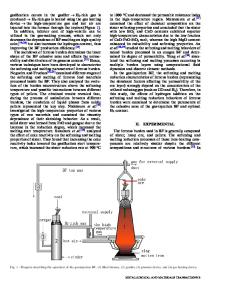A Thermodynamic Model Toward the Comprehension of Ferrous Burden Softening and Melting Using FactSage Macro-Processing
- PDF / 2,970,910 Bytes
- 13 Pages / 593.972 x 792 pts Page_size
- 71 Downloads / 342 Views
ION
THE blast furnace is a countercurrent reactor where iron-bearing materials (lump ore, sinter, and pellets) and metallurgical coke are charged as discrete layers at the top of the furnace, while preheated air and auxiliary fuels are injected through the tuyeres. During descent of the burden, the ferrous materials undergo reduction reactions, softening and melting. As a result, a region known as the cohesive zone is formed, which consists of a series of annular layers of semimolten and impermeable ferruginous material, separated by coke layers (slits) that allow the gas to flow.[1,2] The cohesive zone influences the permeability, and hence the gas and liquids distribution in the furnace, thus controlling process performance and productivity.[3,4] A narrow ISMAEL VEMDRAME FLORES and MAURI´CIO COVCEVICH BAGATINI are with the Ironmaking Processes Laboratory (LPS), Federal University of Minas Gerais (UFMG), PO Box 31270-901, Belo Horizonte, Brazil. Contact e-mail: ismaelvemdramefl[email protected] ALINE LIMA DA SILVA is with the Metallurgical and Materials Department, Federal University of Minas Gerais (UFMG), PO Box 31270-901, Belo Horizonte, Brazil. NESTOR CEZAR HECK is with the Computational Thermodynamics for Metallurgy and Materials (NTCm Group), Federal University of Rio Grande do Sul (UFRGS), PO Box 91501-970, Porto Alegre, Brazil. Manuscript submitted December 22, 2018.
METALLURGICAL AND MATERIALS TRANSACTIONS B
cohesive zone maximizes its permeability and hence productivity, while a zone positioned deep in the furnace minimizes heat consumption, lowering production costs and provides the possibility to reduce variations in hot metal composition and temperature.[5] According to many authors,[5–9] the high-temperature properties of the iron-bearing materials mainly control the width and position of the cohesive zone in the furnace. To access the high-temperature characteristics of ferrous materials, softening and melting (S&M) under load tests are commonly used. In those experiments, a packed bed (usually sandwiched between two coke layers) is heated up to 1873 K using a programmed, time-dependent variation of temperature, reducing gas composition and load.[10] The properties of the sample are obtained by the measurement of bed contraction, gas permeability, degree of reduction, and temperature of the melts formation.[10] Interrupted S&M tests at specific temperatures or contraction levels are also commonly carried out to determine the structural, physical, and chemical characteristics of different samples. However, both types of S&M experiments cannot continuously access parameters such as phase composition, liquid ratio, and slag viscosity, which are essential to elucidate the mechanisms responsible for S&M behaviors of ferrous materials.
To overcome such experimental limitation and to obtain a more fundamental understanding of the S&M phenomena, studies assisted by thermodynamic commercial packages have been carried out. Kemppainen et al.[11] and Guo et al.[12] have computed phase diagrams designed to investigat
Data Loading...











